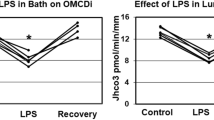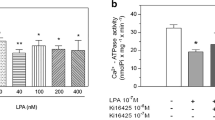Summary
The rabbit renal papillary epithelial cell line PAP-HT25 accumulates sorbitol and other organic osmolytes when cultured in hypertonic media. When returned to isotonic media, PAP-HT25 cells swell because of water influx and then shrink to their normal volume because of rapid osmolyte and water efflux (volume regulatory decrease, VRD). Sorbitol efflux from PAP-HT25 cells during VRD was reduced to 18% of control by incubation of the cells with 100 μm eicosatetraynoic acid (ETYA), indicating that an enzyme that metabolizes arachidonic acid (AA) is a key component of the efflux process. Sorbitol efflux was unaffected by incubation with cyclooxygenase and lipoxygenase inhibitors but was reduced to 9% by incubation with 100 μm ketoconazole and to 37% by incubation with 100 μm SKF-525A, indicating that the cytochrome P-450 limb of the AA cascade is involved in the efflux process. The efflux of other organic osmolytes betaine and myoinositol, but not glycerolphosphorylcholine, was also inhibited by incubation with ETYA and ketoconazole.
Similar content being viewed by others
References
Bagnasco, S., Balaban, R., Fales, H. M., Yang, Y., Burg, M. 1986. Predominant osmotically active organic solutes in rat and rabbit renal medullas.J. Biol. Chem. 261:5872–5877
Bagnasco, S. M., Murphy, H. R., Bedford, J. J., Burg, M. B. 1988. Osmoregulation by slow changes in aldose reductase and rapid changes in sorbitol flux.Am. J. Physiol. 254:C788-C792
Bagnasco, S. M., Uchida, S., Balaban, R. S., Kador, P. F., Burg, M. B. 1987. Induction of aldose and sorbitol in renal inner medullary cells by elevated extracellular NaCl.Proc. Natl. Acad. Sci. USA 84:1718–1720
Beetens, J. R., Loots, W., Somers, Y., Coene, M. C., De Clerck, F. 1986. Ketoconazole inhibits the biosynthesis of leukotrienes in vitro and in vivo.Biochem. Pharmacol. 35:883–891
Ben-Gigi, G., Polacheck, I., Eilam, Y. 1988. In vitro synergistic activity of ketoconazole with trifluoperazine and with chlorpromazine against medically important yeasts.Chemotherapy 34:96–100
Bevan, C., Thiess, C., Kinne, R. K. H., 1990. Role of Ca2+ in sorbitol release from rat inner medullary collecting duct (IMCD) cells under hypoosmotic stress.Biochem. Biophys. Res. Commun. 170:563–568
Glain, J. A., Shearer, G. 1965. Inhibition of soya lipoxidase.J. Sci. Food Agri. 16:273–378
Bradford, M. M. 1976. A rapid and sensitive method for the quantitation of microgram quantities of protein utilising the principle of protein dye binding.Anal. Biochem. 72:248–254
Capdevila, J., Gil, L., Orellana, M., Marnett, L. J., Mason, I., Yadagiri, P., Falck, J. R. 1988. Inhibitors of cytochrome P-450-dependent arachidonic acid metabolism.Arch. Biochem. Biophys. 261:257–263
Carroll, M. A., Louzan, M., McGiff, J. C. 1990. K+ alters cytochrome P-450-dependent arachidonate metabolism by rabbit renomedullary cells.Am. J. Physiol. 258:F1084-F1089
Corey, E. J., Munroe, J. E. 1982. Irreversible inhibition of prostaglandin and leukotriene biosynthesis from arachidonic acid by 11,12-dehydro- and 5,6-dehydroarachidonic acids, respectively.J. Am. Chem. Soc. 104:1752–1754
Corey, E. J., Park, H. 1982. Irreversible inhibition of the enzymic oxidation of arachidonic acid to 15-(hydroperoxy)-5,8,11(Z),13(E)-eicosatetraenoic acid (15-HPETE) by 14,15-dehydroarachidonic acid.J. Am. Chem. Soc. 104:1750–1752
Downing, D. T., Ahern, D. G., Bachta, M. 1970. Enzyme inhibition by acetylenic compounds.Biochem. Biophys. Res. Commun. 40:218–223
Escalente, B., Falck, J. R., Yadagiri, P., Sun, L., Laniado-Schwartzman, M. 1988. 19(S)-Hydroeicosatetraenoic acid is a potent stimulator of renal Na+ K+ ATPase.Biochem. Biophys. Res. Commun. 152:1269–1274
Fitzpatrick, F. A., Murphy, R. C. 1989. Cytochrome P-450 metabolites of arachidonic acid: Formation and biologic actions of “epoxygenase”-derived eicosanoids.Pharmacol. Rev. 40:229–241
Garcia-Perez, A., Burg, M. B. 1991. Renal medullary organic osmolytes.Physiol. Rev. (in press)
Garty, H., Furlong, T. J., Ellis, D. E., Spring, K. R. 1991. The sorbitol permease: An apical membrane transporter in cultured renal papillary epithelial cells.Am. J. Physiol. 260:F650-F656
Grunewald, R. W., Kinne, R. K. H. 1989. Intracellular sorbitol content in isolated rat inner medullary collecting duct cells.Pfluegers Arch. 414:178–184
Hammarstrom, S. 1977. Selective inhibition of plateletn-8 lipoxygenase by 5,8,11-eicosatriynoic acid.Biochem. Biophys. Res. Commun. 487:517–519
Henrich, W. L., Falck, J. R., Campbell, W. B. 1990. Inhibition of renin release by 14,15-epoxyeicosatrienoic acid in renal cortical slices.Am. J. Physiol. 258:E269-E274
Hoffman, E. K., Simonson, L. O. 1989. Membrane mechanisms in volume and pH regulation in vertebrate cells.Physiol. Rev. 69:315–382
Irvine, R. F. 1982. How is the level of free arachidonic acid controlled in mammalian cells?Biochem. J. 204:3–16
Laposata, M., Kaiser, S. L., Reich, E. L., Majerus, P. W. 1987. Eicosadiynoic acid: A nontoxic inhibitor of multiple enzymatic steps in the production of icosanoids from arachidonic acid.Prostaglandins 33:603–613
Moriyama, T., Garcia-Perez, A., Burg, M. B. 1990. Factors affecting the ratio of the different organic osmolytes in renal medullary cells.Am. J. Physiol. 259:F847-F858
Morrison, A. R., Pascoe, N. 1981. metabolism of arachidonate through NADPH-dependent oxygenase of renal cortex.Proc. Natl. Acad. Sci. USA 78:7375–7378
Nakanishi, T., Balaban, R. S., Burg, M. B. 1988. Survey of osmolytes in renal cell lines.Am. J. Physiol. 24:C181-C191
Nakanishi, T., Burg, M.B. 1989. Osmoregulation of glycerophosphorylcholine content of mammalian renal cells.Am. J. Physiol. 257:C795-C801
Nakanishi, T., Turner, R. J., Burg, M. B. 1989. Osmoregulatory changes in myoinositol transport by renal cells.Proc. Natl. Acad. Sci. USA 86:6002–6006
Nakanishi, T., Turner, R. J., Burg, M. B. 1990. Osmoregulation of betaine transport in mammalian renal medullary cells.Am. J. Physiol. 258:F1061-F1067
Needleman, P., Turk, J., Jakschik, B. A., Morrison, A. R., Lefkowith, J. B. 1986. Arachidonic acid metabolism.Annu. Rev. Biochem. 55:69–102
Oesch, F., Bently, P., Golan, M., Stasiecki, P. 1985. Metabolism of benzo(a)pyrene by subcellular fractions of rat liver: evidence for similar patterns of cytochrome P-450 in rough and smooth endoplasmic reticulum but not in nuclei and plasma membrane.Cancer Res. 45:4838–4843
Oliw, E. H., Lawson, J. A., Brash, A. R., Oates, J. A. 1981. Arachidonic acid metabolism in rabbit renal cortex.J. biol. Chem. 256:9924–9931
Oliw, E. H., Moldeus, P. 1982. Metabolism of arachidonic acid by isolated rat hepatocytes, renal cells, and by some rabbit tissues.Biochim. Biophys. Acta 721:135–143
Oliw, E. H., Oates, J.A. 1981. Rabbit renal cortical microsomes metabolize arachidonic acid to trihydroxyeicosatrienoic acids.Prostaglandins 22:863–871
Orning, L., Hammarstrom, S. 1980. Inhibition of leukotriene C and leukotriene D biosynthesis.J. Biol. Chem. 255:8023–8026
Rouzer, C. A., Ford-Hutchinson, A. W., Morton, H. E., Gillard, J. W. 1990. MK886, a potent and specific leukotriene biosynthesis inhibitor blocks and reverses the membrane association of 5-lipoxygenase in ionophore challenged leukocytes.J. Biol. Chem. 265:1436–1442
Salari, H., Braquet, P., Borgeat, P. 1984. Comparative effects of indomethacin, acetylenic acids, 15-HETE, nordihydroguaiaretic acid, and BW755C on the metabolism of arachidonic acid in human leukocytes and platelets.Prostaglandins Leukotrienes Med. 13:53–60
Samples, D. R., Sprague, E. A., Harper, M. J. K., Herlihy, J. T. 1989. In vitro adsorption losses of arachidonic acid and calcium ionophore A23187.Am. J. Physiol. 257:C1166–1170
Schlondorff, D., Petty, E., Oates, J. 1987. Epoxygenase metabolites of arachidonic acid inhibit vasopressin response in toad bladder.Am. J. Physiol. 253:F464-F470
Schwartzman, M., Ferreri, N. R., Carroll, M. A., Songu-Mize, E., Mcgiff, J. C. 1985. Renal cytochrome P-450-related arachidonate metabolite inhibits Na+−K+ ATPase.Nature 314:620–622
Siebens, A. W., Spring, K. R. 1989. A novel sorbitol transport mechanism in cultured renal papillary epithelial cells.Am. J. Physiol. 257:F937-F946
Sok, D.-E., Han, C.-R., Pai, J.-K., Sih, C. J. 1982. Inhibition of leukotriene biosynthesis by acetylenic analogs.Biochem. Biophys. Res. Commun. 107:101–108
Sonino, N. 1987. The use of ketoconazole as an inhibitor of steroid production.N. Engl. J. Med. 317:812–818
Stasiecki, P., Oesch, F. 1980. Distribution of enzymes involved in metabolism of polycyclic aromatic hydrocarbons among rat liver endomembranes and plasma membranes.Eur. J. Cell Biol. 21:79–92
Takahashi, K., Capdevila, J., Karara, A., Falck, J., Jacobson, H. R., Badr, K. F. 1990. Cytochrome P-450 arachidonate metabolites in rat kidney: I. Characterization and hemodynamic responses.Am. J. Physiol. 258:F781-F789
Taylor, A. S., Morrison, A. R., Russell, J. H. 1985. Incorporation of 5,8,11,14-eicosatetraynoic acid (ETYA) into cell lipids: Competition with arachidonic acid for esterification.Prostaglandins 29:449–458
Tobias, L. D., Hamilton, J. G. 1979. The effect of 5,8,11,14-eicosatetraynoic acid on lipid metabolism.Lipids 14:181–193
Uchida, S., Green, N., Coon, H., Triche, T., Mims, S., Burg, M. 1987. High NaCl induces stable changes in phenotype and karyotype of renal cells in culture.Am. J. Physiol. 22:C230-C242
Waite, M. 1987. Phospholipases. Handbook of Lipid Research. Vol. 5. Plenum, New York
Wolff, S. D., Yancey, P. H., Stanton, T. H., Balaban, R. S. 1989. A simple HPLC method for quantitating major organic solutes of renal medulla.Am. J. Physiol. 256:F954-F956
Zablocki, K., Miller, S. P. F., Garcia-Perez, A., Burg, M. B. 1990. Inhibition of GPC degradation causes its accumulation in osmotically stressed renal cells.J. Am. Soc. Nephrol. 1:710 (abstr.)
Author information
Authors and Affiliations
Rights and permissions
About this article
Cite this article
Furlong, T.J., Moriyama, T. & Spring, K.R. Activation of osmolyte efflux from cultured renal papillary epithelial cells. J. Membrain Biol. 123, 269–277 (1991). https://doi.org/10.1007/BF01870410
Received:
Revised:
Issue Date:
DOI: https://doi.org/10.1007/BF01870410




